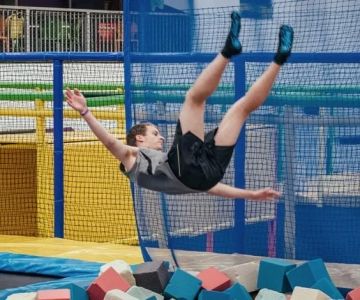- 1-Understanding-the-Benefits-and-Risks-of-Trampoline-Training-for-Dogs
- 2-Preparing-Your-Dog-and-Trampoline-for-Training
- 3-Step-by-Step-Guide-to-Safe-Dog-Trampoline-Training
- 4-Common-Mistakes-to-Avoid-When-Training-Dogs-on-Trampolines
- 5-Real-Life-Stories-of-Successful-Dog-Trampoline-Training
- 6-Where-to-Find-the-Best-Trampoline-Products-for-Dogs
1. Understanding the Benefits and Risks of Trampoline Training for Dogs
Training dogs on a trampoline can be a fun and effective way to enhance their physical fitness, coordination, and mental stimulation. When done correctly, it promotes balance and strengthens muscles, helping dogs stay active and healthy. However, it is vital to understand the potential risks involved. Without proper guidance, trampoline use can lead to injuries such as strained joints or falls.
Knowing how to train dogs on a trampoline safely means balancing these benefits with caution. Recognizing your dog's physical limitations and temperament is key to preventing accidents and ensuring a positive experience.
2. Preparing Your Dog and Trampoline for Training
Before starting trampoline training, ensure your trampoline is suitable for canine use. A stable, durable trampoline with a non-slip surface minimizes the risk of injury. Additionally, clear the area around the trampoline to prevent distractions or accidents.
Prepare your dog by gradually introducing them to the trampoline environment. Let them sniff and explore while offering treats and praise. This step reduces fear and builds positive associations. Ensure your dog is in good health, consulting a vet if necessary, especially for breeds prone to joint issues.
3. Step-by-Step Guide to Safe Dog Trampoline Training
Start by encouraging your dog to place paws on the trampoline edge, rewarding calm behavior. Progressively, coax them onto the surface, maintaining a slow pace to build confidence. Use treats and verbal encouragement generously.
Once comfortable, introduce simple commands like “sit” or “stay” on the trampoline to develop control. Avoid forcing your dog to jump excessively; instead, focus on balance and gentle movement. Always supervise closely to intervene if your dog shows signs of distress or fatigue.
4. Common Mistakes to Avoid When Training Dogs on Trampolines
One frequent mistake is rushing the process, pushing dogs too quickly onto the trampoline, which can cause fear or injury. Another is neglecting supervision or using a trampoline without proper safety features. Avoid over-exerting your dog, especially puppies or senior dogs, who may be more susceptible to strain.
Consistency is crucial; sporadic training sessions confuse dogs and reduce effectiveness. Lastly, using punishment instead of positive reinforcement can harm your dog's trust and willingness to participate.
5. Real-Life Stories of Successful Dog Trampoline Training
Consider Bella, a lively Labrador who initially hesitated to step onto the trampoline. Through patient and gradual introduction, her owner helped her gain confidence. Bella now enjoys gentle exercises that improve her balance and energy levels, much to the delight of her family.
Similarly, Max, a small terrier, overcame anxiety around the trampoline by combining treats and playtime, demonstrating that how to train dogs on a trampoline safely involves understanding each dog's unique personality and needs.
6. Where to Find the Best Trampoline Products for Dogs
For those ready to begin trampoline training, Trampoline Zone offers a curated selection of trampolines designed for pet safety and comfort. Their products include features such as reinforced frames, non-slip mats, and adjustable tension to accommodate different dog sizes.
Additionally, Trampoline Zone provides expert advice and training resources to help dog owners embark on this rewarding activity safely and successfully.







 UPTOWN JUNGLE FUN PARK | Murrieta, CA4.0 (938 reviews)
UPTOWN JUNGLE FUN PARK | Murrieta, CA4.0 (938 reviews) Play and Spin3.0 (982 reviews)
Play and Spin3.0 (982 reviews) Xtreme Energy4.0 (203 reviews)
Xtreme Energy4.0 (203 reviews) Urban Air Trampoline and Adventure Park4.0 (1030 reviews)
Urban Air Trampoline and Adventure Park4.0 (1030 reviews) Urban Air Trampoline and Adventure Park4.0 (814 reviews)
Urban Air Trampoline and Adventure Park4.0 (814 reviews) Pat O'Rourke Recreation Center4.0 (204 reviews)
Pat O'Rourke Recreation Center4.0 (204 reviews) Are Trampoline Parks Safe for Kids? Essential Guide for U.S. Parents
Are Trampoline Parks Safe for Kids? Essential Guide for U.S. Parents How Often Should You Replace Trampoline Springs? Tips for Proper Maintenance
How Often Should You Replace Trampoline Springs? Tips for Proper Maintenance How Much Is a Trampoline? A Detailed Guide to Trampoline Costs and Buying Tips
How Much Is a Trampoline? A Detailed Guide to Trampoline Costs and Buying Tips Bounce Techniques for Stronger Legs: Effective Exercises and Tips
Bounce Techniques for Stronger Legs: Effective Exercises and Tips Essential Music Gear for Trampoline Dance: Complete Guide
Essential Music Gear for Trampoline Dance: Complete Guide Fun STEM Experiments Using Trampolines to Spark Curiosity and Learning
Fun STEM Experiments Using Trampolines to Spark Curiosity and Learning